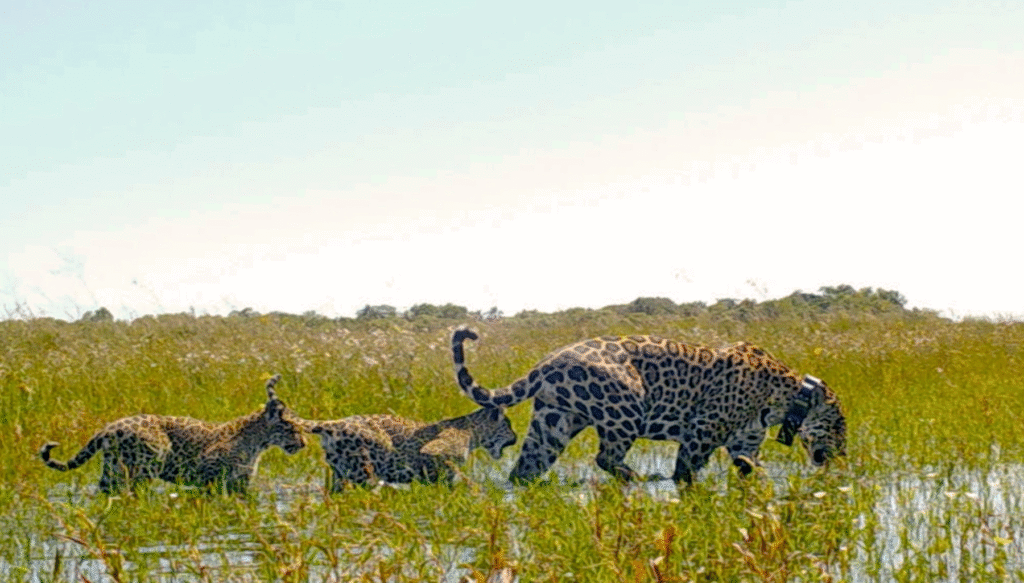Seventy years of silence have been broken. After decades of absence, the powerful roar of the jaguar once again echoes across the vast expanse of the Esteros del Iberá. What was once considered a conservation dream has now become one of South America’s most remarkable rewilding success stories: the return of the continent’s apex predator to Argentina’s crown jewel of wetland ecosystems.
Iberá Wetlands: A Unique Ecosystem for Jaguar Conservation
The Esteros del Iberá, spanning over 1.3 million hectares in Corrientes province, represents one of the largest freshwater wetland systems in South America. This labyrinth of lagoons, floating islands, and gallery forests once teemed with jaguars, the region’s undisputed apex predator. But by the 1950s, hunting and habitat destruction had driven these magnificent cats to local extinction, leaving an ecological void that persisted for seven decades.
Without their top predator, the delicate balance of this wetland paradise began to shift. Prey populations fluctuated without natural regulation, and the ecosystem lost one of its most crucial architects of biodiversity.
The Ambitious Dream of Jaguar Rewilding in Iberá
In 2021, something extraordinary happened. After years of careful planning and preparation by Tompkins Conservationand Rewilding Argentina, the first jaguars in 70 years stepped onto Iberá soil. Mariua, an adult female, and her two cubs, Karai and Porã, became the pioneers of what would grow into one of the world’s most successful large carnivore reintroduction programs.
The project began with meticulous preparation. Scientists and conservationists established the San Alonso Jaguar Reintroduction Center within Iberá National Park, creating a controlled environment where jaguars could acclimate while learning essential survival skills. The program focused not just on individual animals, but on rebuilding an entire ecosystem.
From Eight to Thirty-Five: The Growth of Iberá’s Jaguar Population
What started as a cautious experiment has blossomed into a conservation triumph. Today, more than 35 jaguars roam freely through the Iberá wetlands, transforming from a reintroduced population into a self-sustaining community. This represents one of the fastest large predator recovery programs in conservation history.
The most recent addition to this growing family arrived in January 2025: Takajay, whose name means “strong and brave” in the Wichí language. Born in El Impenetrable National Park in Chaco province as part of a parallel rewilding project, Takajay represents something even more significant than population growth – he embodies genetic diversity and inter-regional cooperation in jaguar conservation.
The Science Behind Jaguar Reintroduction Success
The success of the Iberá jaguar program lies in its comprehensive approach. Rather than simply releasing captive animals, the project carefully considers genetics, behavior, and ecosystem dynamics. Each jaguar is monitored through GPS collars and camera traps, providing scientists with unprecedented insights into their adaptation and territorial behavior.
Takajay’s journey from Chaco to Corrientes exemplifies the program’s sophistication. As the son of Qaramta, a wild jaguar, and Tania, a captive-born female, he represents the perfect blend of wild instincts and human-assisted conservation. His arrival not only increases population numbers but also introduces crucial genetic variability to ensure the long-term health of the Iberá population.
Nature-Based Tourism: How Jaguars Are Revitalizing Iberá’s Economy
The return of jaguars has triggered an unexpected phenomenon – the rise of nature-based tourism in the region. What was once an economically marginalized area has become a destination for wildlife enthusiasts from around the world. Local communities have embraced their role as guardians of these magnificent cats, finding new livelihoods in eco-tourism, guiding, and conservation work.
Hotels, restaurants, and tour operators have emerged to serve visitors eager to catch a glimpse of South America’s largest predator in its natural habitat. The economic impact extends far beyond tourism, creating a sustainable model where conservation directly benefits local communities.
Challenges and Triumphs in Jaguar Conservation
The road to recovery hasn’t been without obstacles. Recent fires have damaged park infrastructure and threatened the habitat, but remarkably, all released jaguars have survived and continued to thrive. This resilience speaks to both the adaptability of these magnificent cats and the robustness of the reintroduction program.
Camera traps reveal encouraging signs: jaguars are establishing territories, hunting successfully, and, most importantly, reproducing. The sight of cubs born in the wild – the first in Iberá for seven decades – represents the ultimate validation of this conservation effort.
A Model for Global Conservation: Lessons from Iberá
The Iberá jaguar program has become a beacon for conservation efforts worldwide. It demonstrates that with sufficient commitment, scientific rigor, and community support, even locally extinct species can return to reclaim their ancestral homes. The success has inspired similar programs across Latin America and serves as proof that large-scale ecosystem restoration is not only possible but essential.
The Future of Iberá: Expanding Conservation and Sustainable Development
Looking ahead, the vision for Iberá extends beyond the current 35-40 jaguars. Scientists project that the wetlands can sustainably support a much larger population. The provincial government has reaffirmed its commitment to Iberá’s growth as a premier tourist destination, with Governor Gustavo Valdés emphasizing that “Iberá is a bit of everything: conservation, tourism, gastronomy, public works, and culture.”
Plans for 2025 include installing new ranger stations, tourism infrastructure projects, restoration of historic sites, environmental education programs, international certifications, and training programs for entrepreneurs, chefs, and artisans. The goal is to consolidate the Esteros del Iberá as one of Argentina’s best tourist offerings, positioning Corrientes not only as a land of nature and biodiversity but as an example of integration between conservation and sustainable economic development.
Conclusion: A Victory for Conservation and Hope for the Future
The return of jaguars to Iberá is more than a conservation success story – it’s a testament to the power of persistence, scientific innovation, and the indomitable will of nature to heal when given the chance. The arrival of a wild jaguar in September 2025 adds an extraordinary final note to this symphony of restoration: proof that when we restore ecosystems properly, nature not only responds but actively participates in its own recovery.
In the spotted coat of each jaguar prowling through the wetlands – whether carefully reintroduced or naturally arrived – we see reflected our own capacity for restoration and hope. The wild jaguar’s presence transforms the narrative from “we brought them back” to “they came home on their own,” elevating this from a human achievement to a collaborative victory between science and nature.
The roar has returned to Iberá, and now it echoes with both the voices of careful conservation and wild freedom. In this harmony between human intervention and natural recovery, we find not just the restoration of a species, but proof that our most damaged relationships with the natural world can not only be repaired but can flourish beyond our wildest dreams.
The jaguars of Iberá stand as living proof that when science, conservation, and community unite, miracles are not just possible – they’re inevitable.
Ready to Explore Esteros del Iberá?
If you’re ready to experience the magic of Esteros del Iberá and witness the incredible conservation efforts firsthand, contact me today! Whether you’re an eco-tourist or a wildlife enthusiast, let me guide you through one of South America’s most remarkable ecosystems.
Click the button below to WhatsApp me directly and let’s plan your adventure in the Iberá Wetlands!
🌍 Ready to explore Esteros del Iberá and witness its incredible conservation efforts firsthand? Contact me today to plan your adventure and learn more about the Iberá Wetlands!

